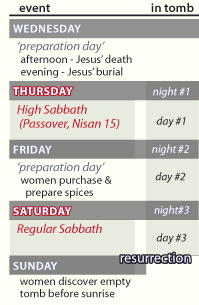Three days or two days?
Matthew 12:40—(Question #1): “Jesus predicted that he would be in the grave 3 days 3 nights, but he was only in the grave two nights and one full day.”
The Gospels do not say that Jesus was crucified on a Friday; they only say he was crucified on “the day of Preparation” before a Sabbath. Tradition has assumed this was Friday, since Saturday was the normal Sabbath day. But actually there were two types of Sabbaths:
- The regular weekly Sabbath (always Saturdays)
- The ‘special’ or ‘high’ Sabbaths commanded in Exodus 12 & Leviticus 23, which could fall on any day of the week.
 Which type of Sabbath did Jesus die just before? John 19:31 tells us that this was not a normal Sabbath but the “high Sabbath” or “special Sabbath” of the Passover or Feast of Unleavened Bread (Nisan 15th by the Jewish calendar). This indicates that there was a ‘double Sabbath’, first the high Sabbath (Thursday) then the regular Sabbath (Saturday).
Which type of Sabbath did Jesus die just before? John 19:31 tells us that this was not a normal Sabbath but the “high Sabbath” or “special Sabbath” of the Passover or Feast of Unleavened Bread (Nisan 15th by the Jewish calendar). This indicates that there was a ‘double Sabbath’, first the high Sabbath (Thursday) then the regular Sabbath (Saturday).
When we look at the events between the crucifixion and the resurrection, we get another indication that there must have been two separate Sabbaths in between. The gospel of Luke tells us:
The women who had come with him from Galilee followed and saw the tomb and how his body was laid. Then they returned and prepared spices and ointments. On the Sabbath they rested according to the commandment. – Luke 23:55
Then we read more details about this in Mark:
When the Sabbath was past, Mary Magdalene and Mary the mother of James and Salome bought spices, so that they might go and anoint him. And very early on the first day of the week, when the sun had risen, they went to the tomb. – Mark 16:1,2
If we use a Friday crucifixion date, this wouldn’t work, because there would have been no time for them to return and prepare the spices Friday evening. This task is forbidden under Jewish Sabbath law as it is work, and the verse tells us that they kept the Sabbath. So there must have been a non-Sabbath day between the crucifixion and the first day of the week.
The Gospels tell us that the women arrived Sunday morning “very early” “while it was still dark” (John 20:1; Luke 24:1) and the resurrection had already happened before they came. This would fit with a normal understanding of three days and three nights in the tomb.
A Second Interpretation
Another possible interpretation relates to how Jewish culture and language count days and nights. In Jewish culture, any part of a day is counted when reckoning a consecutive period of time, and a day is reckoned from sundown to sundown. Since Jesus was in the grave for part of Friday, Saturday, and part of Sunday, by Hebrew reckoning he was in the grave for three days.
The phrase “three days and three nights” is a Jewish figure of speech which simply means three days; in the language of the day one would never say “three days and two nights.” This is rather like the English expression “biweekly,” which technically means once every two weeks, but in common speech it generally means twice a week. A clear demonstration of this Jewish understanding of the phrase “three days and three nights” is found in the Book of Esther where the queen said that no one was to eat or drink for three days, night or day (Esther 4.16), but on the third day, when only two nights had passed, she went into the king’s chamber and the fast was ended. The book of Tobiah (200BC) gives an even clearer confirmation of this usage(3:12-13): “At such words she went into an upper room in the house and did not eat and drink three days and three nights, and continued to pray and weep asking God to keep her from shame [she was accused of murder]. Thereafter, on the third day, having completed her prayer, she praised God…”
So you have to understand not the translation, but how words and idiom are used in the original languages of scripture. Deedat’s argument here is as naïve as arguing that since the Torah and Qur’ān use plural “we” for God, they both teach multiple Gods.
Related Articles: